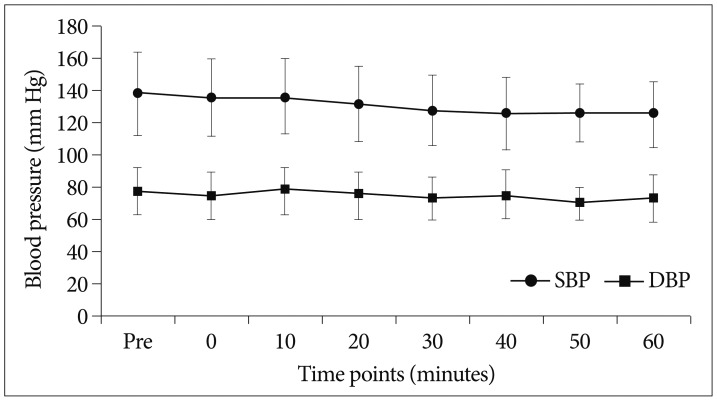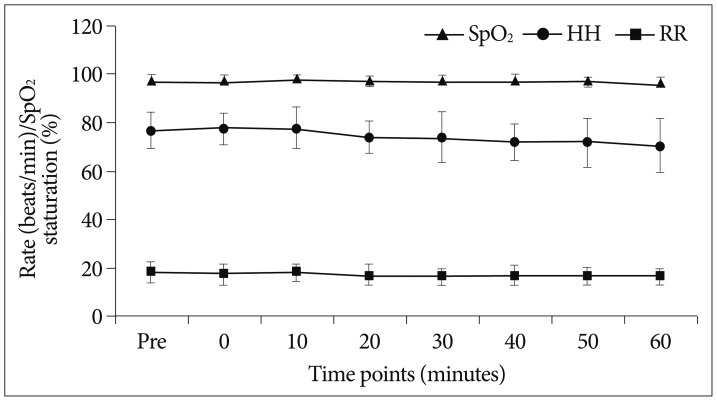J Korean Neurosurg Soc.
2014 Apr;55(4):185-189. 10.3340/jkns.2014.55.4.185.
Usefulness of Dexmedetomidine during Intracerebral Aneurysm Coiling
- Affiliations
-
- 1Department of Neurosurgery, College of Medicine, Yeungnam University, Daegu, Korea. cch0102@ynu.ac.kr
- KMID: 2191089
- DOI: http://doi.org/10.3340/jkns.2014.55.4.185
Abstract
OBJECTIVE
General anesthesia is often preferred for endovascular coiling of intracranial aneurysm at most centers. But in the authors' hospital, it is performed under monitored anesthesia care (MAC) using dexmedetomidine. To determine the feasibility and safety of this approach, the authors reviewed our initial experience.
METHODS
Retrospective data was analyzed from July 2012 to November 2012. We performed coil embolization in 28 cases using this method. Among them, for statistical significance, we analyzed 12 cases in which the procedure time exceeded an hour. Vital signs were analyzed every 10 minutes. Depth of sedation was measured according to the Ramsay sedation scale and frequency of the repeated roadmap image(s) caused by movement of the patient's head during the procedure.
RESULTS
All procedures were completed without occurrence of procedure related complications. Under MAC using dexmedetomidine, vital signs of the patients were stable, no statistical significance regarding hemodynamic and respiratory parameters was observed between time points (p>0.05). Adequate sedation was achieved. Mean Ramsay sedation scale was 3.67+/-1.61 (2 to 6). Repeated roadmap image(s) due to patient's factor occurred in only one case. The mean dosage of drug for adequate sedation for the procedure was 0.65+/-0.12 mcg/kg/hr without loading doses.
CONCLUSION
To the best of my knowledge, this is the first report published in English using the method of monitored anesthesia with dexmedetomidine for intracranial aneurysm coiling. Monitored anesthesia care using dexmedetomidine without loading dose for embolization of intracranial aneurysms appeared to be a safe and effective alternative to general anesthesia.
Keyword
MeSH Terms
Figure
Reference
-
1. Arain SR, Ruehlow RM, Uhrich TD, Ebert TJ. The efficacy of dexmedetomidine versus morphine for postoperative analgesia after major inpatient surgery. Anesth Analg. 2004; 98:153–158. PMID: 14693611.
Article2. Aryan HE, Box KW, Ibrahim D, Desiraju U, Ames CP. Safety and efficacy of dexmedetomidine in neurosurgical patients. Brain Inj. 2006; 20:791–798. PMID: 17060146.
Article3. Bekker A, Sturaitis MK. Dexmedetomidine for neurological surgery. Neurosurgery. 2005; 57(1):suppl. 1–10. discussion 1-10. PMID: 15987564.
Article4. Bloor BC, Ward DS, Belleville JP, Maze M. Effects of intravenous dexmedetomidine in humans. II. Hemodynamic changes. Anesthesiology. 1992; 77:1134–1142. PMID: 1361311.5. Connolly ES Jr, Rabinstein AA, Carhuapoma JR, Derdeyn CP, Dion J, Higashida RT, et al. Guidelines for the management of aneurysmal subarachnoid hemorrhage : a guideline for healthcare professionals from the American Heart Association/American Stroke Association. Stroke. 2012; 43:1711–1737. PMID: 22556195.
Article6. Ebert TJ, Hall JE, Barney JA, Uhrich TD, Colinco MD. The effects of increasing plasma concentrations of dexmedetomidine in humans. Anesthesiology. 2000; 93:382–394. PMID: 10910487.
Article7. Jones M, Leslie K, Mitchell P. Anaesthesia for endovascular treatment of cerebral aneurysms. J Clin Neurosci. 2004; 11:468–470. PMID: 15177384.
Article8. Jorden VS, Pousman RM, Sanford MM, Thorborg PA, Hutchens MP. Dexmedetomidine overdose in the perioperative setting. Ann Pharmacother. 2004; 38:803–807. PMID: 15039474.
Article9. Khan ZP, Munday IT, Jones RM, Thornton C, Mant TG, Amin D. Effects of dexmedetomidine on isoflurane requirements in healthy volunteers. 1 : Pharmacodynamic and pharmacokinetic interactions. Br J Anaesth. 1999; 83:372–380. PMID: 10655905.
Article10. Lee S, Kim BH, Lim K, Stalker D, Wisemandle W, Shin SG, et al. Pharmacokinetics and pharmacodynamics of intravenous dexmedetomidine in healthy Korean subjects. J Clin Pharm Ther. 2012; 37:698–703. PMID: 22650799.
Article11. Manninen PH, Chan AS, Papworth D. Conscious sedation for interventional neuroradiology : a comparison of midazolam and propofol infusion. Can J Anaesth. 1997; 44:26–30. PMID: 8988820.
Article12. Martin E, Ramsay G, Mantz J, Sum-Ping ST. The role of the alpha2-adrenoceptor agonist dexmedetomidine in postsurgical sedation in the intensive care unit. J Intensive Care Med. 2003; 18:29–41. PMID: 15189665.
Article13. McCallum JB, Boban N, Hogan Q, Schmeling WT, Kampine JP, Bosnjak ZJ. The mechanism of alpha2-adrenergic inhibition of sympathetic ganglionic transmission. Anesth Analg. 1998; 87:503–510. PMID: 9728818.
Article14. Qureshi AI, Suri MF, Khan J, Kim SH, Fessler RD, Ringer AJ, et al. Endovascular treatment of intracranial aneurysms by using Guglielmi detachable coils in awake patients : safety and feasibility. J Neurosurg. 2001; 94:880–885. PMID: 11409514.
Article15. Ramsay MA, Luterman DL. Dexmedetomidine as a total intravenous anesthetic agent. Anesthesiology. 2004; 101:787–790. PMID: 15329604.
Article16. Ramsay MA, Savege TM, Simpson BR, Goodwin R. Controlled sedation with alphaxalone-alphadolone. Br Med J. 1974; 2:656–659. PMID: 4835444.
Article17. Rark R. ASA Standards, Guidelines and Statements. Park Ridge: American Society of Anesthesiologists;2007.18. Talke P, Chen R, Thomas B, Aggarwall A, Gottlieb A, Thorborg P, et al. The hemodynamic and adrenergic effects of perioperative dexmedetomidine infusion after vascular surgery. Anesth Analg. 2000; 90:834–839. PMID: 10735784.
Article19. Varma MK, Price K, Jayakrishnan V, Manickam B, Kessell G. Anaesthetic considerations for interventional neuroradiology. Br J Anaesth. 2007; 99:75–85. PMID: 17562678.
Article20. Venn RM, Bradshaw CJ, Spencer R, Brealey D, Caudwell E, Naughton C, et al. Preliminary UK experience of dexmedetomidine, a novel agent for postoperative sedation in the intensive care unit. Anaesthesia. 1999; 54:1136–1142. PMID: 10594409.
Article
- Full Text Links
- Actions
-
Cited
- CITED
-
- Close
- Share
- Similar articles
-
- Double Microcatheter-Assisted Coiling of a Basilar Artery Fenestration Aneurysm
- Early Rupture after Coiling of Unruptured Aneurysm
- Coiling as Retreatment in Intracranial Aneurysm of de novo Formation or Regrowth: Case Report
- A Complicated Case of Endovascular Stent Assisted Coil Embolization of an Aneurysm
- Coil Embolization for Distal Middle Cerebral Artery Aneurysm




